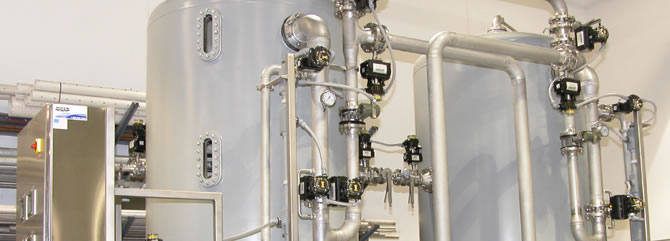
Demineralization Solutions
All naturally occurring water contains dissolved mineral salts. While in solution, these salts separate into positively charged cations and negatively charged anions. Through the process of ion exchange, demineralization can significantly reduce the levels of these ions, thereby lowering the conductivity.
The process begins when raw water is passed through cation exchange resin. The cation resin is in the hydrogen form (H+) and exchanges all the positively charged ions for hydrogen, thus converting all the impurities in the water into acids.
The acidic effluent water from the cation exchange is then passed through anion exchange resin. The anion resin is in the hydroxyl form (OH-) and exchanges all the negatively charged ions into the hydroxyl form, completing the conversion of all impurities into water (H+ + OH- --> H2O), thus providing pure demineralized water.
Dual bed demineralizers use separate tanks; one containing cation resin, the other containing anion resin. A weak base dual-bed demineralizer produces water with a resistance of approximately 50 kOHM/cm, and strong base dual-bed units produces water with a resistance of about 200 kOHM/cm.
Mixed bed demineralizers utilize a single vessel, to thoroughly mix both the cation and anion resins. The mixed resin configuration produces a much higher water quality than a conventional dual-bed system. In fact, our typical mixed-bed demineralizers are designed to produce water with greater than 18 megOHM/cm resistance.
Common Applications
- Power Generation
- Industrial Process
- Ultrapure Polishing
- High Pressure Boiler Makeup
Typical Features
- Welded and Powder Coated Steel Skid Frames
- High Quality, Non-Code, Rubber Lined Steel or FRP Pressure Vessels
- High Quality Ion Exchange Resins
- Schedule 80 PVC Internals and Manifold Plumbing
- High Quality Actuated Control Valves
- U.L. 508A Control Panel Fabrication
- Allen-Bradley® PLC/HMI/VFD Controls
- Flow Transmitters
- Pressure Transmitters
- Acid/Caustic Transmitters
- Resistivity Transmitters
- Sampling Ports
- Skid Mounting (pre-plumbed, pre-wired & tested)
- Chemical Feed Pumps
Optional Features
- ASME Code Pressure Vessels
- Stainless steel or Hastelloy Piping and Internal Distributors
- Stainless Steel Skid Frames
- Recirculation Pumps (for polishing effluent to desired quality)
- Neutralization Systems
